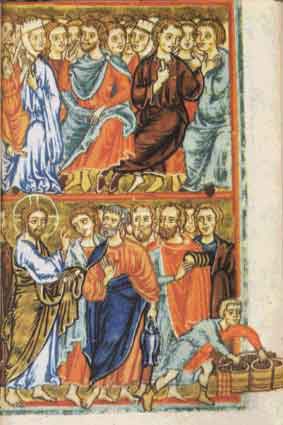|
X |
||||
| Three weeks prior to Ash Wednesday, on the day before Septuagesima Sunday, a touching ceremony is held. A choir assembles, chants the divine office and, afterwards, sings a bittersweet hymn bidding farewell to the word "Alleluia": | ||||
We do not now deserve |
||||
| That ceremony, known as the Depositio of the Alleluia, ushers in the season of Septuagesima, the roughly seventy days prior to Easter that help us make the transition from the joy of Epiphany to the penitence of Lent. | ||||
 |
So important was Lent to both Eastern and Western Christians that they actually had a separate season to prepare for it. Thus, the day after Septuagesima Sunday, they would begin a period of voluntary fasting that would grow more severe as it approached the full and obligatory fast of Lent. The amount of food would be reduced, and the consumption of certain items, such as butter, milk, eggs, and cheese, would gradually be abandoned. Starting on the Thursday before Ash Wednesday, this self-imposed asceticism would culminate in abstinence from meat. Thus the name for this seven-day period before Ash Wednesday, is "Carnival," from the Latin carne levarium, meaning "removal of meat." Finally, within the week of Carnival, the last three days (the three days prior to Lent) would be reserved for going to confession This period was known as "Shrovetide," from the old English word "to shrive," or to have one's sins forgiven through absolution. | |||
| These incremental steps eased the faithful into what was one of the holiest -- and most demanding -- times of the year. Lent is a sacred period of forty days set aside for penance, contrition, and good works. Just as Septuagesima imitates the seventy years of Babylonian exile (see elsewhere), Quadragesima ("forty," the Latin name for Lent) imitates the holy periods of purgation recorded in the Old Testament. The Hebrews spent forty years wandering in the wilderness after their deliverance from the Pharoah and before their entrance into the Promised Land. Moses, representative of the Law, fasted and prepared forty days before ascending Mount Sinai, as did Elias, the greatest of the Hebrew prophets. (So too did the gentile Ninevites in response to Jonah's prophecy.) Moreover, these Old Testament types are ratified by the example of our Lord, who fasted forty days in the desert before beginning His public ministry. | ||||
|
Lazarus & the Rich Man, Third Sunday of Lent |
Given the significance of the number forty as a sign of perfection-through-purgation, it is little wonder that Lent became associated early on with two groups of people: public penitents and catechumens. The former were sinners guilty of particularly heinous crimes. To atone for their sins, they received a stern punishment from their bishop on Ash Wednesday and then spent the next forty days wearing sackloth and ash and not bathing. The visual, tactile, and odiferous unpleasantness of this practice was meant to remind others-- and themselves -- of the repulsiveness of sin. These penitents would remain in this state until they were publicly welcomed back into the Church during a special Mass on Maundy Thursday morning. Catechumens, on the other hand, underwent a rigorous period of instruction and admonition during Lent. They, too, were not allowed to bathe as part of their | |||
| contrition for past sins. Near the start of Lent they would be exorcized with the formula that is still used in the traditional Roman rite of baptism: "Depart, thou accursed one!" In the middle of Lent they would learn the Apostle's Creed so that they could recite it on Holy Saturday, and on Palm Sunday they would learn the Lord's Prayer. Finally, on Holy Thursday they would bathe and on Holy Saturday undergo a dramatic ritual during the Easter Vigil formally initiating them into the Body of Christ. Over time, all Catholics would imitate these two groups as a recognition of personal sinfulness and as a yearly re-avowal of the Christian faith. Lent is thus not only a time to probe the dark recesses of our fallen souls and to purge ourselves, with the cooperative grace of Christ, of our stains, but to be renewed in our commitment to live a holy Christian life. | ||||
| Lent is often thought of as an undifferentiated block of time preceding Easter: It is not. There are actually several distinct "mini-seasons" within Lent designed to move the believer from a more general recognition of the need for atonement (Ash Wednesday to the third Sunday of Lent) to a more specific meditation on the passion of Jesus Christ (Passion Sunday and Palm Sunday). These two periods, in turn, are separated by a brief interlude of restrained joy called mid-Lent, which begins on the Wednesday before Laetare Sunday and ends the Wednesday after. Finally, the meditation on our Lord's suffering culminates during Holy Week with a Mass each day presenting a different Gospel account of the Passion, the divine office of Tenebrae on Spy Wednesday, and the three great liturgies of the Triduum (Maundy Thursday, Good Friday, and Holy Saturday) that dwell at length on the final events of Christ's earthly life and the mysteries of the Christian Pasch. |
Multiplication of Bread & Fishes, Laetare Sunday |
|||
|
||||



